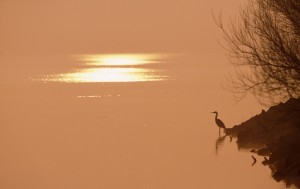What do herons eat? Well….
Standing as tall as a child and with a wingspan exceeding six feet, one of the most instantly recognisable birds on the Basin is the grey heron.
At this time of year they are nesting in the nearby estate at Kinnaird, and numbers are around 5-10 birds. As the nesting season finishes, adults and juveniles make their way to the Basin to feed and this number rockets and in late summer we can have up to 70-80 herons visiting the reserve.

Many people are fascinated by a stalking heron. They seem to spend hours in the pools in front of the Visitor Centre, not flinching, simply watching. Watching, waiting and hoping for its next meal to come along and this leads to one of the most frequently asked questions in the Centre, what do herons eat?
Herons are predators; hunting for fish, amphibians, reptiles, insects and small mammals. They are also opportunistic which means they are very unlikely to pass up the chance of an easy meal. You may also be surprised at some of the other prey we have seen herons take here at Montrose.
Back in February, I took advantage of a tea break between meetings, spending 10 minutes looking out from the Visitor Centre to see what birds were on the Reserve.
There was nothing unusual about for that time of year, plenty of pintail, wigeon, teal and eider roosting out on the open water and redshank, greenshank and other waders running up and down the shoreline.
Just then a grey heron came in and landed within the Centre grounds, scaring off the mixed flock of finches which had been feasting on the last remaining grass and teasel seeds.
Strutting around with the confidence only a heron can pull off, the bird quietly made its way over to a large clump of bushes, suddenly stopping without moving an inch. After what seemed like an age, the bird slowly crept toward the bushes and disappeared into the dark, stalking some unsuspecting soul.
Reappearing into the open, the heron had caught a huge rat!
Held tightly in its beak, the heron dropping the rat onto the ground in order to turn it round, making it easier to swallow which it did in one quick flick of the head.
Unfortunately for the heron, the rat appeared to get stuck in its throat and for a while it was walking around with a large lump about half-way down its long neck. In what looked to me like an attempt to swallow, the bird kept opening its beak to reveal what I thought was its tongue, only to realise that what I was seeing, was in fact, the tail of the doomed rodent, lodged in the bird’s throat!
Not giving up, the bird found a nice quite spot amongst some rush, where it sat, finally managing to swallow its prize meal, before beginning the search for its next meal.
I have in the past also witnessed a heron try to unsuccessfully swallow an already dead male goldeneye on Larne Lough, County Antrim; but this is the first time I have ever seen one take a rodent as large as a rat, which due to the movement of the tail protruding from the birds beak, I presume was alive when it caught it.

Since this sighting of the rat-catching heron, we have also seen a heron patiently watching the sand martins flying around the artificial wall in front of the viewing gallery. Next thing we knew the heron had grabbed a sand martin, dunked it in the pool and swallowed it whole!
Unfortunately we didn’t see the heron actually catch the martin, so it is unclear whether it was caught mid-flight, as it was entering or leaving a nesting hole or perhaps as it was on the ground collecting nesting material or fighting with another sand martin, but one thing is clear – it certainly was fascinating viewing.
Adam – Montrose Basin Ranger
Help protect Scotland’s wildlife
Our work to save Scotland’s wildlife is made possible thanks to the generosity of our members and supporters.
Join today from just £3 a month to help protect the species you love.
Preface
Standing as tall as a child and with a wingspan exceeding six feet, one of the most instantly recognisable birds on the Basin is the grey heron. At this time …
